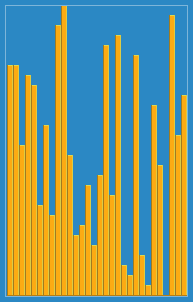 Insertion sort animation | |
| Class | Sorting algorithm |
|---|---|
| Data structure | Array |
| Worst-case performance | comparisons and swaps |
| Best-case performance | comparisons, swaps |
| Average performance | comparisons and swaps |
| Worst-case space complexity | total, auxiliary |
| Optimal | No |
Insertion sort is a simple sorting algorithm that builds the final sorted array (or list) one item at a time by comparisons. It is much less efficient on large lists than more advanced algorithms such as quicksort, heapsort, or merge sort. However, insertion sort provides several advantages:
- Simple implementation: Jon Bentley shows a version that is three lines in C-like pseudo-code, and five lines when optimized.[1]
- Efficient for (quite) small data sets, much like other quadratic (i.e., O(n2)) sorting algorithms
- More efficient in practice than most other simple quadratic algorithms such as selection sort or bubble sort
- Adaptive, i.e., efficient for data sets that are already substantially sorted: the time complexity is O(kn) when each element in the input is no more than k places away from its sorted position
- Stable; i.e., does not change the relative order of elements with equal keys
- In-place; i.e., only requires a constant amount O(1) of additional memory space
- Online; i.e., can sort a list as it receives it
When people manually sort cards in a bridge hand, most use a method that is similar to insertion sort.[2]
- ^ Cite error: The named reference
pearlswas invoked but never defined (see the help page). - ^ Sedgewick, Robert (1983). Algorithms. Addison-Wesley. p. 95. ISBN 978-0-201-06672-2.


